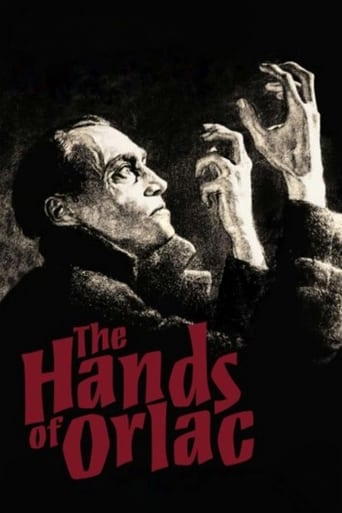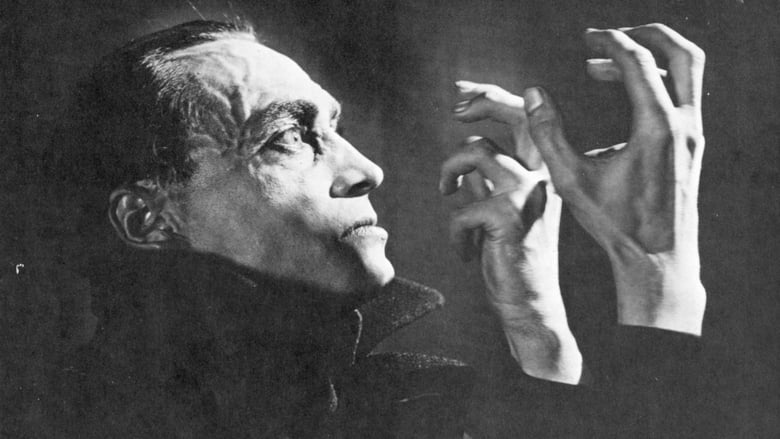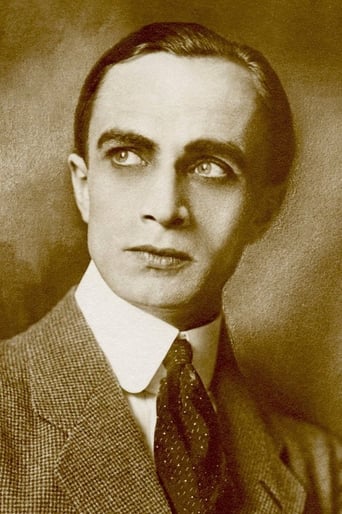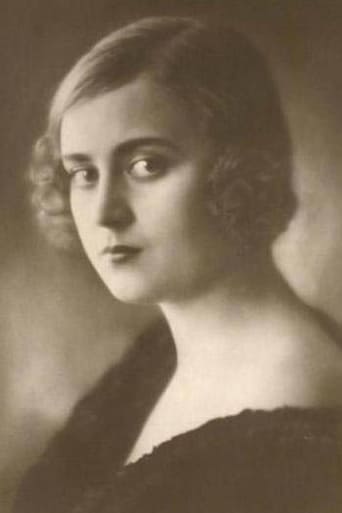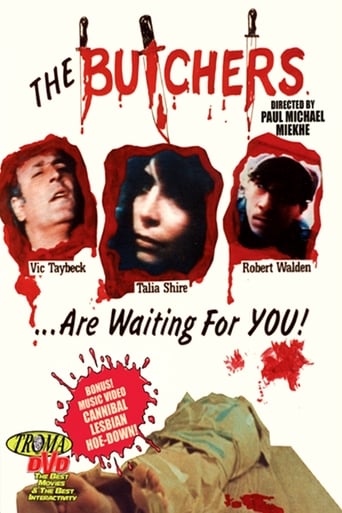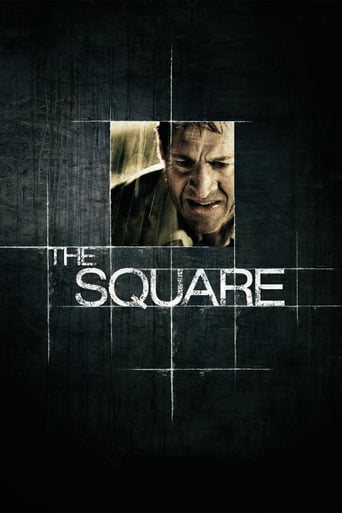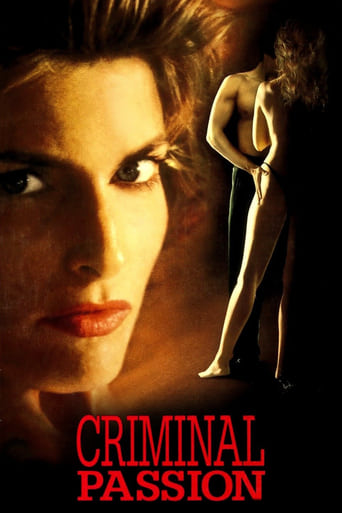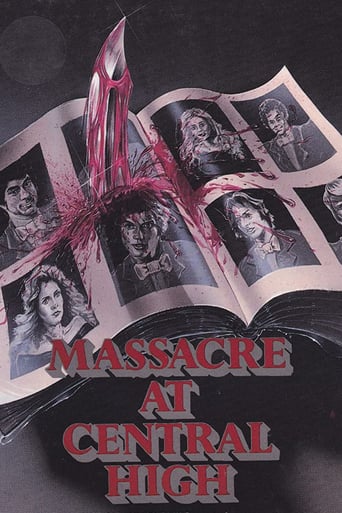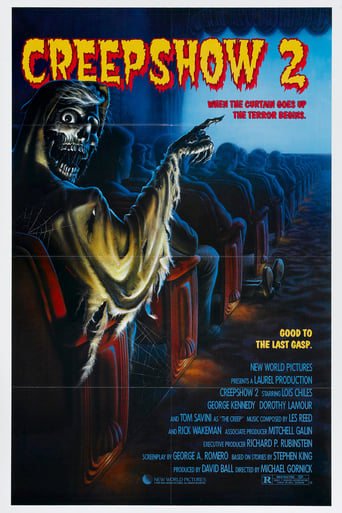The Hands of Orlac (1928)
A world-famous pianist loses both hands in an accident. When new hands are grafted on, he is horrified to learn they once belonged to a murderer.
Watch Trailer
Cast


Similar titles
Reviews
Great Film overall
I think this is a new genre that they're all sort of working their way through it and haven't got all the kinks worked out yet but it's a genre that works for me.
The story, direction, characters, and writing/dialogue is akin to taking a tranquilizer shot to the neck, but everything else was so well done.
what a terribly boring film. I'm sorry but this is absolutely not deserving of best picture and will be forgotten quickly. Entertaining and engaging cinema? No. Nothing performances with flat faces and mistaking silence for subtlety.
I watched THE HANDS OF ORLAC on TMC, when they featured at least three, maybe four movies dealing with the subject of hands. The first was HANDS OF A STRANGER, which is based on this silent film. However, when I recorded THE HANDS OF ORLAC, I hadn't realized that is was a silent film. I find them to be very slow and plodding, which this film was. However, it was also very confusing. There was one character, introduced early in the film, interacting with the maid; but, we didn't know who he was; and, I won't spoil it for anyone. But, the dialog just didn't make sense in the context of the film. The cinematography, especially during the scene with the train was very impressive; but, after that the lighting was inconsistent and very dark. The plot was fairly linear; but, there were a number of jump cuts that seemed jolting. The idea of transplanting human body parts seems very much ahead of its time, just as The Modern Promethius was ahead of its time. It was a good watch; but, it was a long two hours.
I realize this movie was a true original. Well, kind of, anyway. Maurice Renard wrote the novel in 1920, and he wrote the original mixed-up transplant novel in 1908 about organs being transplanted not just from human to human but to animals, plants, and even machines. One wonders what it must have been like to be Maurice Renard's room mate. But, in fact, maybe the whole business began with Mary Shelley's "Frankenstein" and lasted at least through the latest version of "The Fly" and "Robocop." Anyway, yes, I realize the film is an original and that it was directed by the same guy, Robert Wiene, who had earlier given us "The Cabinet of Dr. Caligari," which I truly believe was dreamed up on some kind of amusement park ride.But, man, this is one slow slog. Example: Conrad Veidt as Orlac has discovered his hands have been transplanted from a murderer and he sits brooding on the couch. Behind him stands his wife, Alexandra Sorina, staring at him without his realizing that she's there. I tried to time the motionless scene in which she stares at his back and he sits, but my LED clock was in shadow and I couldn't read it. It must be thirty full seconds. Nothing happens. Finally she drops -- verrry slowwwly -- to her knees and creeps towards him until she's able to nuzzle his hand. Veidt jerks it away in disgust.I hate modern movies that are stylishly edited so that each shot lasts a fraction of a second, but this was like watching actors move inside a huge vat of corn syrup. Sorina overacts too. Everybody is expected to overact in a silent movie but this goes a bit over the edge. Veidt, the central figure, has a handle on his role and projects emotions exquisitely. The doctor too reins himself in, though that doesn't stop him from looking like a chump from the Keystone Cops.There's none of the loop-the-loop quality of "Dr. Caligari." There aren't any surprises in the set dressing or the story itself, once we get the picture. Although it's dark, it's been beautifully photographed. Superb use is made of lights in night-for-night shots. The musical score is hard to assess. It sounds like The World Saxophone Quartet for strings, full of extended shimmering dissonant chords and occasional weird shrieks and squeaks. I kind of enjoyed it.It was more or less remade ten years later as "Mad Love" with Peter Lorre in the role of a crazed doctor who performs the transplants. The victim is treated coincidentally. "Mad Love" goes nuts at the end. At least this one is grounded, given the initial fantastic premise.But, mind you, it IS slow.
A famous pianist (Conrad Veidt) has his hands crushed in a train accident, and he receives new ones through an experimental transplant. But whose hands were they before? The hands of a killer!This is a rather long film, probably more than it needs to be. The train wreck shots are beautiful, but go on a while, with the story being relatively simple.The focus here is more on Orlac's mental state, and less on the others in any way, with the love affair angle of "Mad Love" (its remake) completely absent. For fans of "Mad Love", this picture needs to be respected, as they clearly borrowed scenes (noticeably where Orlac meets his donor), but "Mad Love" is the superior film in many ways.
I'm glad I had this chance to check out yet another German Expressionist classic even if I had to make do with faint Spanish subtitles over the original German intertitles (then again, the narrative is easy enough to follow)! It took me some time to warm up to the film: the pace is extremely sluggish (the aftermath of the train-wreck at the beginning seemed interminable), while the all-important decision to exchange the damaged hands of famed concert pianist Orlac with those of a murderer felt too abrupt.In preparation for this review, I re-read Michael Elliott's comments on the film: while I generally concur with his opinion, at this stage I wouldn't put this above the 1935 Karl Freund/Peter Lorre/Colin Clive remake MAD LOVE (Ted Healy's intrusive comedy relief, to me, is just about the only negative element in that film while adding Dr. Gogol's obsessive yearning for Orlac's wife, hence the new title). Still, I was surprised by how much the later film actually followed the Silent version especially the two scenes in which Orlac meets the 'executed' murderer of the Maurice Renard story; another remake appeared in 1960, co-starring Christopher Lee and which I watched on Italian TV not too long ago but already can hardly remember anything about it! Conrad Veidt's lanky figure and stylized approach to acting perfectly suited the requirements of the leading role (his posture generally echoing that of Cesare the Somnambulist in the same director's THE CABINET OF DR. CALIGARI [1919]); the expressionist sets were also notable but the film's style is generally an internalized one in that it deals primarily with Orlac's state of mind filming him in tight shots whenever possible. However, the avant-garde score which accompanied the Grapevine Video edition I watched was a matter of taste featuring a female vocalist who frequently attempted to simulate the various characters' emotions with an annoying array of wails, shrieks and faint whispers! It's unfortunate, too, that the backlog I have of unwatched films on DVD doesn't permit me to check out the Kino edition of CALIGARI for the moment especially since it contains a lengthy condensed version of another intriguing Wiene title, GENUINE: A TALE OF A VAMPIRE (1920)

